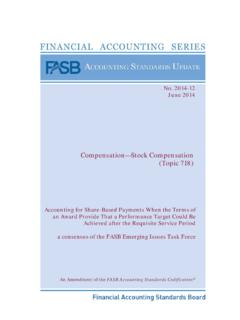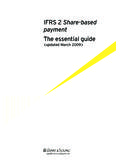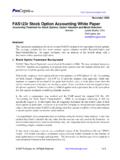Transcription of A case study of accounting and tax treatment of …
1 Journal of Business Cases and Applications Volume 20 A case study , Page 1 A case study of accounting and tax treatment of celebrity endorsement contracts Peter Fuchsteiner St. Cloud State University Kris Portz St. Cloud State University ABSTRACT This case study involves an analysis how Generally Accepted accounting Principles (GAAP) and Federal Income Tax law impact accounting for athlete s/celebrity s endorsement contract costs. Companies such as Nike and Under Armour pay athletes millions of dollars on long term contracts to endorse their products and to enhance their corporate images. The case examines when these costs should be expensed or capitalized on companies financial statements and income tax returns. It also examines ancillary questions of if these costs should be considered product costs or period costs; if liabilities should be created if an athlete should bring disfavor on herself/himself; how bonus payments for extraordinary performance should be accounted for; and what financial statement disclosure of contract details should occur.
2 Keywords: Endorsement contracts, GAAP, tax code, capitalization, advertising expense Copyright statement: Authors retain the copyright to the manuscripts published in AABRI journals. Please see the AABRI Copyright Policy at Journal of Business Cases and Applications Volume 20 A case study , Page 2 INTRODUCTION Background Companies such as Nike and Under Armour pay athletes millions of dollars on long term contracts to endorse their products and to enhance their corporate images. The case examines when these costs should be expensed or capitalized on companies financial statements and income tax returns. It also examines ancillary questions of if these costs should be considered product costs or period costs; if liabilities should be created if an athlete should bring disfavor on herself/himself; how bonus payments for extraordinary performance should be accounted for; and what financial statement disclosure of contract details should occur.
3 This is accomplished in a case study format which allows students to critically examine these issues and reach their own conclusions. accounting for endorsement contracts is both complex and varied depending upon the specific contract language. In general, students should conclude that most of the time costs related to these contracts are expensed, although an alternative accounting treatment would be to capitalize the costs and amortize over the future anticipated benefit periods. These costs are period costs, not product costs, analogous to advertising. Liabilities for potential future losses, due to actions which may cause the athlete to be viewed unfavorably, are not likely to be accrued. Bonus payments are not accrued until the athlete s performance has achieved the specific contract goals. Most companies do not disclose contract details as this information is considered proprietary.
4 Federal income tax treatment should require capitalization of these contracts and amortization expense should be recognized over the period the athlete performs services under the contract. Learning Objectives and Suggested Use of the Case The overall objective of the case is to have students analyze how Generally Accepted accounting Principles (GAAP) and Federal Income Tax law impact accounting for athlete s/celebrity s endorsement contract costs. More specifically, the learning objectives of the case are for students to: 1. distinguish expensing versus capitalizing endorsement contract costs. 2. determine whether endorsement contract payments should be considered product costs or period costs. 3. determine if a liability should be recorded on financial statements if an athlete brings disfavor on herself/himself and vicariously, the company. 4. determine if and when bonus payments for performance must be accrued.
5 5. determine what endorsement contract details must be disclosed in the financial statements and footnotes. 6. determine the proper income tax treatment of endorsement contract costs. This case is suitable for financial accounting courses at the intermediate and advanced levels for undergraduate as well as graduate students. The case could also be simplified for a lower level accounting course to give students a relatable context in which to discuss the concepts of accruing versus expensing, product versus period costs, or contingent liabilities. The case also includes a question on the tax treatment of endorsement contracts which would be Journal of Business Cases and Applications Volume 20 A case study , Page 3 appropriate for an upper-level business tax course. Overall, the case is flexible and allows instructors to select appropriate case questions that correspond to their curricular needs.
6 The case discussion can be done in class or in an online environment. If desired, instructors could also assign the case as a written homework assignment and include a research element, asking students to formulate their responses by researching GAAP in the FASB Codification database or tax code using available tax research databases. Going beyond the discussion questions of the case, students could review corporate annual reports and compare differences in how companies account for these contracts, where the contracts are reported in the financial statements, and what contract details are disclosed in the footnotes. To further pique student interest or add an element of fun, students could search for specific contract provisions and terms of endorsement contracts of their favorite athletes, celebrities, or teams and share their findings with the class. Students could also share commercials or ads demonstrating the endorsement contracts at work.
7 An online environment would work especially well for some of these additional activities. One pedagogical benefit of the case is that it brings real life into the classroom and encourages critical thinking through examination of a topic many students are naturally interested in. Students have their favorite celebrities and may even buy the products they endorse. They understand how endorsements increase brand recognition and value. They are captivated by the scandal stories and are crushed when star athletes experience season ending injuries. While celebrity endorsements are generally understood by students, they likely have not considered how they are accounted for by corporations. A second pedagogical benefit of the case is that it is not overly complicated or intimidating, and is short enough for an in-class discussion without significant prep work by students. Yet, the case is easily scalable into a more significant class project to include GAAP or tax research, a writing element, and/or a presentation element.
8 The authors are not aware of any other instructional cases in the accounting education literature which address the accounting treatment for endorsement contracts, even though these contracts are prevalent and reported in the annual reports of many companies. THE CASE PRESENTED TO STUDENTS The Case Situation In 2017, the New England Patriots and Atlanta Falcons battled it out on the field in Superbowl LI. Atlanta led by as much as 28-3, but the Patriots managed an impressive comeback and went on to win in overtime. The game was broadcast on Fox with an estimated million viewers worldwide. The Patriots and the Falcons weren t the only organizations who competed in the exciting game. Corporate competitors, Nike and Under Armour battled too. The Patriot s record setting quarterback, Tom Brady, endorses Under Armour. Matt Ryan, quarterback of the Atlanta Falcons, endorses Nike.
9 A few weeks before the Superbowl, Under Armour announced the release of the Athlete Recovery Sleepwear otherwise known as Tom Brady s jammy pants. Brady even sported his pajama pants at a press conference. Fans went crazy for the jammy pants and tweeted, If you wear Tom Brady s pajama pants, you ll be able to play football like Tom Brady and Need a pair of Tom Brady s magic pajamas. Losing the game had double meaning for Ryan. Not only Journal of Business Cases and Applications Volume 20 A case study , Page 4 did Ryan have to endure a second half collapse on the field, Ryan lost millions in future endorsement revenues contractually tied to winning the game. Corporate competition between Nike and Under Armour has been brewing for some time, as both companies search for champion athletes or even teams to endorse. Companies use endorsements as a mode of advertising to increase consumer interest in products and/or services.
10 In return for an endorsement, athletes are compensated. The compensation structure and the respective duties of the company and the athlete are written into a contract. Endorsement deals are structured in a variety of ways and can range anywhere from more than $100 million to nothing more than free equipment. Arrangements can include base pay (up front followed by additional payments), bonus payouts for major victories or accomplishments, lifetime contracts that extend beyond the playing duties of the athlete, revenue sharing deals (royalties), or even equity stakes in the company. For example, Brady receives Under Armour stock instead of cash. The value of his Under Armour stock is estimated to have grown 800% since 2010. Endorsement contracts give a company the legal right to use the player s name and image. The player s name and image can be used in many forms, such as print media, online or television.
















